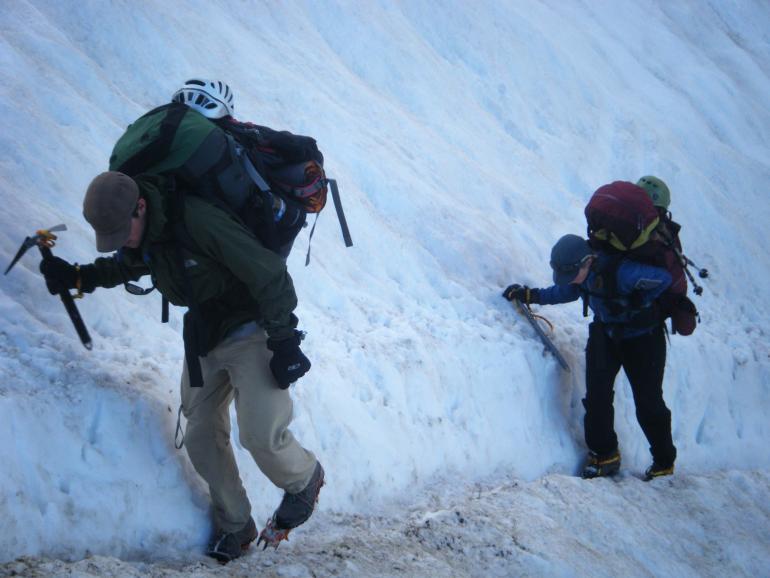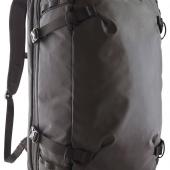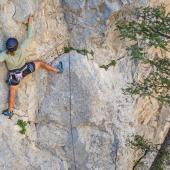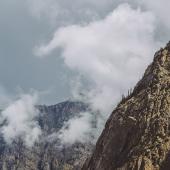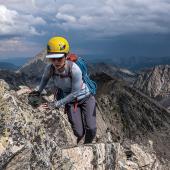Fire on the Mountain
The Grand Teton is a striking 13,770-foot spire of rock that rises dramatically out of the Teton Range in northwest Wyoming. It’s a common destination for Montana mountaineers, and accidents are not uncommon on this classic alpine peak. On July 21, 2010, a severe freak electrical storm blew in, trapping 17 climbers on the mountain and prompting a massive rescue effort. And just when this brutal storm was bearing down, four Bozeman climbers—Alan Kline, Betsy Smith, Matt “Junior” Walker, and Andrew Larson—were only 100 feet from the summit.
Alan, a tall, fun-loving climbing guide with a deep passion for the mountains, was leading the group. Betsy, his adventurous blond girlfriend, had traveled around the country with Alan for the last three years, racking up a massive resume of climbing experience. Junior, a handsome, dark-haired Midwest transplant who had less mountaineering skill than his friends, was eager to meet the challenge of one of Wyoming’s toughest mountains. And at 24, Andrew possessed extensive winter climbing experience and had organized the trip weeks before.
At 5:30am, the climbers left their base camp on the lower saddle of Grand Teton and began their attempt for the summit. Via the Lower Owen-Spalding to the Upper Exum Ridge, the group broke into two teams and simul-climbed at a brisk pace, reasoning they would be able to summit and return to the safety of the lower saddle by noon with plenty of time to avoid the predicted late afternoon thundershowers.
They kept a close eye on the clouds, agreeing that if any foreboding weather blew in, they would make a hasty retreat back to base camp. Other than a thin band of darker clouds to the south, everything seemed fine. Nothing looked ominous.
The Storm Descends
By 10:15, the darker clouds turned north and began to bear down on the Grand, limiting the climbers’ visibility with thick snow flurries. Just 100 feet from the summit, the storm began to show its raw electrical power: Alan and Betsy’s metallic climbing equipment began to vibrate against their bodies. Realizing the carabiners and gear were transforming them into lightning rods, the pair hurriedly stripped off any metal, stuffed it into their packs, and threw everything into a small rock alcove. Crouching in a shallow cave 20 feet around the corner from their gear, they nervously waited for the second team to join them.
By this time, Junior and Andrew were only a rope-length from the cave but still dangerously exposed on the ridgeline. Pounded by sleet and hail with pulsing thunder in the background, the team frantically scrambled over the wet rock and snowfields to join Alan and Betsy.
On his way to the relative safety of the alcove, a painful surge arced through Junior’s body. “It was like grabbing an electric fence,” he remembers. “I yelled up to my partner, ‘I think I just got struck by lightning!’” Unsure about what had happened, Junior and Andrew reached the shallow cave undeterred and the team huddled inside, trying their best to stay out of the wet sleet and blowing wind.
The alcove was only big enough for three people, so Alan decided to weather the storm just a few feet outside. “At this point, everyone was still optimistic,” he says, noting that while they were now soaking wet, the storm could still blow through and they could continue their summit attempt. “This just couldn’t be the storm they were calling for in the late afternoon,” Alan remembers thinking. “Lightning still wasn’t too big a concern.”
Around 10:30, now five hours since the start of the expedition, the heart of the storm moved closer and an audible buzz filled the air. “It was like the static on a TV screen getting louder and louder,” Betsy says.
Minutes passed. The frightened team knew something had to happen. And that’s when the first big lightning strike hit Alan.
It Does Strike Twice
With an audible pop, lightning struck the mountain. Everyone inside the alcove was scared, slightly jolted, but otherwise all right. After assessing any damage they’d taken, the team looked over to find Alan collapsed in the boulders. He’d taken a direct strike. “I lost consciousness for a few seconds,” he explains, “and then when I woke up, I felt like I was floating… and in the most intense pain of my life.” The other three rushed over in an effort to help, only to find Alan screaming in agony, his muscles tensed from the millions of volts of electricity that had raced through his body.
Even though she had extensive EMT training, Betsy was at a loss. “There was nothing I could do,” she remembers. “I felt like the worst girlfriend in the world.” She performed a basic assessment, reasoning that it was better than nothing.
“Everything hurt, but my back hurt the worst,” Alan says. “It felt like someone injected boiling oil into my veins. Worst pain of my life.” From the core out, Alan slowly regained control of his body, and the team started to calm back down. After shaking off the first hit, Alan’s optimism gradually returned. “I felt relieved, because once I could move my legs again, I remembered the phrase, ‘lightning never strikes twice,’ and figured we’d be ok,” Alan says. “Whoever came up with that saying is a real asshole.”
“Every Thought Was Lightning”
With a tiny break in the weather, they quickly transferred their packs to the higher, larger alcove they had been huddled in, giving up the relative shelter of the cave in hopes that the lightning would strike the gear instead of their bodies.
Their plan worked initially. As soon as the team huddled together, standing on their climbing ropes for insulation, the air slowly began to hum with electricity again. They faced the rising buzz with sickening anticipation, knowing that another crippling strike was imminent. “You could hear it building up, but there’s nothing you can do. You want to run, you want to do something… but you just can’t,” Betsy says. “Every thought was lightning.”
Six or seven times the team heard the growing whine of static followed by the pop of a lightning strike hitting their gear. Twenty minutes passed. “We were talking to each other, and I remember thinking ‘we’re going to be ok, it’ll blow over,’” Junior says. Morale began to improve, and everyone, optimistically, began to think they were safe.
Minutes later, another massive bolt of lightning leveled the group. Alan relates the scene: “You’re paralyzed, but your eyes still work. I could see Betsy and Junior falling down next to me as I was falling down.” After the initial searing pain subsided, the group was now dangerously immobilized: Junior had lost mobility in his right leg, and Betsy couldn’t move at all.
Without any time to recover, another bolt ripped through the sky and electrocuted the team. “This one was the worst for me,” Betsy says. “It felt like you were levitating. You couldn’t feel anything at first, but then you could see smoke coming out of your clothes. You’d hit the ground, and your whole body felt like you didn’t have any bones. Like hot soup inside your clothes.”
The cautious optimism the team experienced before was now nearly gone. “This is when the smell of burning clothes and flesh started to hit me,” Junior remembers. “You could hear everyone screaming.”
Getting Back Down
After the debilitating pain of the fourth strike slowly ebbed, the team could see blue skies through the clouds. Andrew, who was the least immobilized, ventured down the mountain with an extra rope and belay device in search of rescue. Over the next 45 minutes, Alan gathered his incapacitated friends and tried his best to calm them down, realizing that even though the storm had passed, they were still in tremendous danger. They’d survived the lightning, but the risk of frostbite and hypothermia could be just as hazardous. Knowing that rescue would be nearly impossible unless they could get farther down the mountain, Alan began organizing their descent to a helicopter-accessible ridge.
“I ran up to the bags, got all the warm clothes I could find, five ‘biners, webbing, and two belay devices,” Alan says, outlining the gear he collected to build impromptu anchors. In an effort to keep his friends warm, he stuffed the dry clothes inside their jackets for insulation and led them to the cliff edge.
After slinging rock horns and tying off boulders, Alan slowly lowered Betsy, who still hadn’t regained control of her hands. After she was safe, Junior rappelled down to her; due to his still-hobbled right foot, he slipped and swung 30 feet, smashing into an adjacent rock wall. Alan’s guide training kicked in: “I can’t get you out of here on a backboard, Junior!” he cried. “I need you to stay in the game!’”
After seven difficult rappels, the team finally reached the upper saddle and relative safety, meeting Helen, a Jenny Lake ranger who had hiked up for the rescue effort. “She was an angel,” Betsy remembers. “She was glowing.” Wrapping the cold, exhausted climbers in emergency blankets, Helen helped the team down via helicopter evac to the lower saddle. “They put us in full body harnesses and hung us from the helicopter on the flight down. It was awesome. A guilty pleasure,” Junior admits. After being assessed by the rangers, the team was transported via helicopter to Lupine Meadows, and then transferred to St John’s Medical Center by ambulance.
Assessing the Damage
Even though the team didn’t feel overwhelmingly hurt, once in St John’s, their injuries became clear. Betsy had six severe burns from lightning wounds. Her wristwatch had melted to her arm, and her right index finger required amputation from a third-degree burn. Alan went to ICU, suffering chest pains from air around his heart and fluid in his lungs. Along with several other bad burns, Junior’s foot was so badly seared that he required skin grafts. Compounding their difficulties was the risk of kidney failure the whole group faced as their bodies released toxins from the lightning strikes.
Several weeks and multiple surgeries later, the team is doing well. “We’re really lucky to be alive,” Betsy says, considering that out of the 17 climbers trapped on the mountain that day, one fell to his death during the storm and another passed away from complications in the hospital. “And other than being short a finger, I think we’ll all make a full recovery.”
“In 20 years, they’d never seen a storm blow in that early, that fast, or that bad,” Alan says, quoting a Jenny Lake ranger who helped with the rescue. Despite their disaster, each of the climbers is determined to return to Wyoming and make a successful ascent the Grand.

